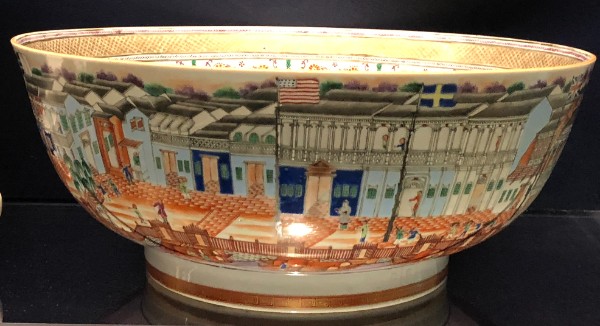2022-6-1
又開車去了一次坐落在莎樂美小鎮上的迪美博物館,詳細參觀了蔭余堂(另文專述)和迪美博物館的外銷藝術展覽,其中有一幅清中期製作的壁畫,是在荷蘭東印度公司就職24年的蘇格蘭商人James Drummond於1807年離開廣州的時候,從海上運回蘇格蘭並裝飾在他在博世郡(Perthshere)城堡中的十九扇壁畫中的一部分,占據了一個展廳,金碧輝煌,壯觀雄偉,描寫的是廣州十叄行的市井風俗,中間有很悽美的故事,堪比清明上河圖。


The Drummond wallpaper. Hand-painted in China in watercolor circa 1780, the lively scene depicts the "hongs"—foreign factories—of Canton (the city now known as Guangzhou)--the only Chinese city open to foreign trade at that time.


Scottish royalty. Enter James Drummond, captain for the East India Tea Company and eighth Viscount of Strathallan, a title that came with a castle. Drummond commissioned the wallpaper, brought it back with him on one of his several trips to China, and hung it in the Ladies' Salon of his castle for almost 200 years. Sometime in the 1980s, it was taken down off of the wooden frames on which it was tacked, rolled up, and began a peripatetic journey. When the paper first came up for sale Bill Sargent, then curator for the Peabody Essex Museum, wanted it but it was in very poor condition and the cost for repair prohibitive.
這是目前所知唯一的廣州十叄行壁畫,瓷器上面的廣東十叄行則比比皆是,迪美美術館了,就有那麼一隻潘趣碗。



James Drummond, 8th Viscount Strathallan (1767-1851) brought his Chinese wallpaper back with him from Canton. Drummond, was a nephew of the London banker Robert Drummond of Cadland, Hampshire, and prospered in the service of the East India Company in China. He began his East India Company career as a supergargo, and became assistant to the Head of the Committee at Canton in 1792, and by 1800 he was a member of the Select Committee there and the following year became President, a post he held until 1807 when he returned to Scotland. The 18 rolls of 12 foot by 4 foot mulberry bark and bamboo paper are hand-painted with a scene of the ‘hongs’, or foreign factories of Canton (Guangzhou), which enable its dating to c.1780. It is decorated the walls of the Ladies’ Salon at Strathallen Castle for almost 200 years, before it was acquired by the Peabody Essex Museum in Salem, Massachusetts. It is the only known example of an historic Chinese wallpaper showing the hongs at Canton, a motif that was shown more often on Chinese export porcelain.

廣州十叄行的行長們的畫像,在迪美博物館裡也有展覽,其中的一位,是清朝六品武官、廣州茶葉和絲綢商人李致祥(Eshing Lee)。李致祥的父親李新華與林則徐是同科進士,又同入翰林院攻讀,憑藉這層關係,李致祥成了林則徐廣州禁煙的得力助手,曾娶美國傳教士之女蘇珊為妻。李致祥的兒子李泉石是清末六品武官,同盟會元老,是黃興的摯友。

該油畫為中國最早的西洋人物畫家關喬昌(林官,Lam Qua)的爺爺關作霖(Guan Zuolin)於1785-1805年在廣州期間所繪。關作霖又叫史貝霖(Spoilum),被稱為第一個憑西方傳統畫像而獲得名聲的廣東藝術家和中國最早的油畫家。他活躍於1774年-1810年左右,作品收藏在當今世界不少收藏機構手裡。Spoilum 具有非凡的才能和多才多藝,他學習了歐洲的倒玻璃繪畫技術,將歐洲凋刻的鏡像複製到玻璃板的背面,並專注於在西方風景前擺姿勢的歐洲人肖像。創作了一些最着名的中國行商畫作,包括潘有度和李致祥等人。

廣東十叄行怡和行的行商伍秉鑒的肖像,迪美博物館收藏
伍秉鑒(1769-1843),別名敦元,字成之,號平湖,商名浩官第二(Howqua II),叄品頂戴花翎,是清中葉着名行商,廣州十叄行之一怡和行的行主。廣東南海人(故居位於廣州市海珠區溪峽一帶),祖籍晉江安海。生前他所經營的怡和行壟斷了中國的對外海上貿易,又通過他的義子鐵路大亨約翰・穆瑞・福布斯名下受其資助的旗昌洋行參與投資密歇根中央鐵路,涉足美國鐵路工業。伍秉鑒的蠟像,在倫敦蠟像館展覽經年。這張肖像的原作,是英國畫家喬治·錢納利(George Chinney)。可是人怕出名豬怕壯,因為伍秉鑒是當時的世界首富,所以他這張肖像的復製品,在世界各大博物館珍藏的不下十幾幅。這一幅作品,是同時期中國畫家關喬昌的父親 Lamqua 的彷作,輕易不拿出來示人的。
Wu Ping-Chien, known as Howqua, lived from 1769 to 1843. As the preeminent hong merchant he amassed one of the greatest fortunes of the early 19th century. Worth $26,000,000 in 1830, he invested in American railroads and other new technology. Renowned in the West, his wax figure was exhibited at Madame Tussaud's in London and a clipper ship was named after him.

廣東十叄行怡和行的行商伍秉鑒的肖像,Attributed to Esther Speakman, (American, c. 1823 - 1875). After George Chinnery, English, 1748 - 1852,費城博物館收藏
This dramatic portrait of the vastly wealthy, highly respected Chinese merchant Hou Qua (1769–1843),one of a small number of individuals that the emperor allowed to trade with the West,is based on a composition by British expatriate artist George Chinnery, who was active in southern China. Chinnery’s painting was brought to Philadelphia in 1828 by Benjamin Chew Wilcocks, a friend of the artist and a businessman and diplomat who played an important role in the American China trade. Wilcocks subsequently commissioned two additional pictures of Hou Qua, one from Philadelphia portraitist Thomas Sully (1783–1872) in 1828 and another, seen here, by American artist/copyist Esther Speakman, who is known to have exhibited such a canvas in Philadelphia in 1843. These multiple representations of the Chinese trader demonstrate the strength of the US market for Chinese imagery, which provided work not only for foreign artists but also for Americans.

廣東十叄行怡和行的行商伍秉鑒的肖像 - 錢納利的原作 - Style of Chinnery (possibly by him). Houqua, ca. 1825. Oil on canvas, 26 × 19 in. (66 × 48.3 cm). Independence Seaport Museum, Philadelphia (88.10).
|

















